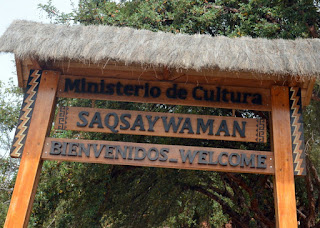Day 4. Giant Tortoises
May 5
After a short stay in Guayaquil and a short night, we were off to the airport again for our flight of about 2 hours to the Galápagos Islands, about 600 miles off the coast of Ecuador.
We landed on a very small island at a very small airport north of the island of Santa Cruz. We queued up with the rest of the passengers. The open air terminal was the place that our luggage underwent multiple inspections. They are very serious here with their motto that we should 'leave nothing here but footprints and take nothing but photos'.
We and our luggage were then bussed a short way to board a ferry to cross over to Santa Cruz Island, boarding another bus to take us to a place on the way to the highlands of the island for our lunch.
The lunch site appeared to be a country home that had a decently large area set up with long tables and a nice buffet lunch. We began to get to know some of our fellow travelers, including a couple from Montreal, a couple of nice women from the Los Angeles area, and some honemooners from Tokyo, who were natives of Japan and Ireland. It's fun to be with such a diverse group of people.
Giant Tortoises
One of the major goals was seeing the Galapagos' famous giant tortoises. We'll that happened today! We were on a private farm that also functions as a tortoise sanctuary. As we took our small bus down a somewhat narrow dirt road through the countryside of the island. Alan was surprised at the human habitation on the island, but the largest community in the Galapagos is on the other side of the island.
The sanctuary is in an area known as the highlands, which is where the adult tortoises spend their lives. The females make their way down to the shore to lay their eggs, and then they return to leave the hatchlings on their own. Only a small percentage make their way back to the highlands, and the rest fall prey to mostly introduced spieces, particularly the black rats that came aboard ships in the 18th and 19th centuries.
As we made our way down the road, we had to slow and swerve several times to avoid tortoises that were in the roadway. We have been reminded several times that this is their island, and we are the visitors; we honor the schedule of territory of our hosts. One of the phrases we've heard is to leave nothing but footprints, and take nothing but pictures and memories. (By the way, we've also been asked not to use flash photography. We are 3 degrees south of the equator here, and the light is supposed to be great in the morning and evening, with pretty harsh light at mid-day when we lunch on the boat and take a siesta.)
When we arrived at the farm, it seemed like a pretty normal farm/tourist attraction. Except for the giant tortoises right by the parking area! We don't see that a lot in Indiana!
We then took a walk back through the preserve to the central office area where there were snacks and drinks waiting for us. It was nice to sit for a bit, but it was also hard not to be back out with the turtles, though some were very near where we were eating.
After a short stay in Guayaquil and a short night, we were off to the airport again for our flight of about 2 hours to the Galápagos Islands, about 600 miles off the coast of Ecuador.
We landed on a very small island at a very small airport north of the island of Santa Cruz. We queued up with the rest of the passengers. The open air terminal was the place that our luggage underwent multiple inspections. They are very serious here with their motto that we should 'leave nothing here but footprints and take nothing but photos'.
We and our luggage were then bussed a short way to board a ferry to cross over to Santa Cruz Island, boarding another bus to take us to a place on the way to the highlands of the island for our lunch.
The lunch site appeared to be a country home that had a decently large area set up with long tables and a nice buffet lunch. We began to get to know some of our fellow travelers, including a couple from Montreal, a couple of nice women from the Los Angeles area, and some honemooners from Tokyo, who were natives of Japan and Ireland. It's fun to be with such a diverse group of people.
Giant Tortoises
One of the major goals was seeing the Galapagos' famous giant tortoises. We'll that happened today! We were on a private farm that also functions as a tortoise sanctuary. As we took our small bus down a somewhat narrow dirt road through the countryside of the island. Alan was surprised at the human habitation on the island, but the largest community in the Galapagos is on the other side of the island.
The sanctuary is in an area known as the highlands, which is where the adult tortoises spend their lives. The females make their way down to the shore to lay their eggs, and then they return to leave the hatchlings on their own. Only a small percentage make their way back to the highlands, and the rest fall prey to mostly introduced spieces, particularly the black rats that came aboard ships in the 18th and 19th centuries.
As we made our way down the road, we had to slow and swerve several times to avoid tortoises that were in the roadway. We have been reminded several times that this is their island, and we are the visitors; we honor the schedule of territory of our hosts. One of the phrases we've heard is to leave nothing but footprints, and take nothing but pictures and memories. (By the way, we've also been asked not to use flash photography. We are 3 degrees south of the equator here, and the light is supposed to be great in the morning and evening, with pretty harsh light at mid-day when we lunch on the boat and take a siesta.)
When we arrived at the farm, it seemed like a pretty normal farm/tourist attraction. Except for the giant tortoises right by the parking area! We don't see that a lot in Indiana!
We then took a walk back through the preserve to the central office area where there were snacks and drinks waiting for us. It was nice to sit for a bit, but it was also hard not to be back out with the turtles, though some were very near where we were eating.
We got back on the bus and drove a little farther, down from the highlands, to the community of Puerto Arroyo. We had about 30 minutes to do some exploring. We looked in some of the shops, but really didn't know what to be expecting in costs and availability in other locations, so it was a lot of looking, and no buying.
We were now ready for our first real experience with traveling between islands in the Galapagos. After arriving at the dock at the appointed time we made our way to a big rubber raft. Our carry on luggage was with us, and our big pieces were put into another zodiac, or panga. We did wear life jackets, which we were grateful for, but it was a little nerve racking to be taking off across the open sea sitting on. the edge of a rubber boat. We were quick to find a rope tied around the edge to hold onto. I'm not sure, but I'm guessing that we had about a 15 minute ride out to our yacht.
Making the transfer from the panga to the boat took a little practice. The sea was a little choppy, and the step up out of the panga changes constantly. Joyce had an issue negotiating that step the first time and bumper her knee and had her arm jerked pretty hard to keep her upright. We perfected the grabbing forearms arrival and departure techniques fairly quickly.
We gathered in the main lounge/bar area and were given general instructions and then called to our cabins one group at a time. The cabin was nice, though we noticed right away that the twin bunks were on opposite sides of the room. We had a small porthole, and nice sized bath (for a ship), a couch, a small, pretty unfunctional desk, and a couch. There was no TV, and enough storage below and above our beds for our luggage. We took some time to get organized and rest a bit before it was time for muster (making sure we knew how to put on our life jackets and get to the muster station in the case of emergency.). After muster, we got an orientation to our expedition time, and then it was time for dinner.
All of the meals on the boat were served buffet style, with three serving stations around the dining room. We gravitated toward a table for 6 in the back corner of the room where we were joined by a young married couple from Japan (Noriko, born in Japan, and Tom, born in Ireland), and a father/son combo (Bill, from Australia, living in Kansas City, and Miles, from New Mexico, but finishing a study abroad semester in South America). It turns out that we shared every meal on the boat with this group, even though the other 31 people seemed to mix and match some.
Dinner was very nice, with a good variety of foods common in Ecuador and the Galapagos, with enough western-leaning things to keep us all happy.
After supper, we spent some time on boat exploration, checking out the three decks. The top deck had the bridge, which we were invited to visit whenever we weren't arriving or leaving port. Also up there there some spaces for lounging in the open air, another smaller bar area, a hot tub, and storage for wet suits and snorkeling gear. The middle deck contained the 20 cabins for the 37 passengers on this boat. The boat also had a small crew. We spent most of our time with the 3 nature interpreters, Dennis, Christopher, and Daniel, and heard regularly from Francisco, the hotel manager, and saw the Captain, doctor, and several of the crew that drove the pandas, cleaned the ship, and took care of feeding us. They were all pretty quiet, but very helpful when we needed them. The lower deck that we were on had the dining room, the main lounge, and a central area for desks and offices, as well as where we usually disembarked from the boat. There was also a magnetic board that we used to indicate if we were on or off the boat. After our tour, we retired to the cabin, to get ready for an early call in the morning. The animals get up at the crack of dawn, and we need to follow their schedule.



Comments
Post a Comment